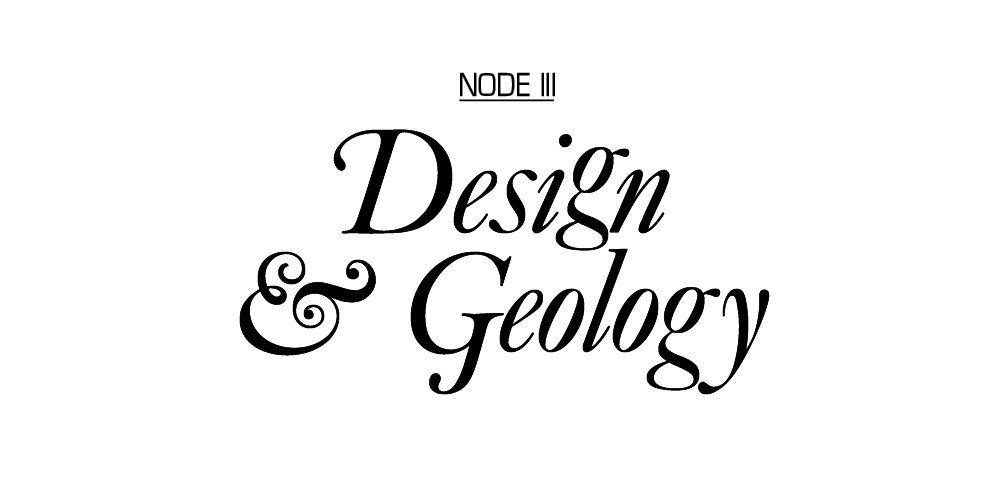
Thursday, 28 January
Node III: Design and Geology
Organised by Petra Lilja with guests Ólöf Erla Bjarnadóttir, Garðar Eyjólfsson, Snæbjörn Guðmundsson, Anna Maria Orrù and Brynhildur Pálsdóttir.
Please note: Design and Geology includes Zoom lectures that are open to the public as well as a workshop. The workshop is for students only (20 max) and requires separate pre-registration.
Introduction
There are many reasons behind the choice of theme for the node, Design and Geology. The notion of the Anthropocene is becoming established and used in many contexts to describe our planetary age as a new geological epoch, defined by unparalleled human influence upon the Earth. Evidence for this originates from human activities that leave large-scale impacts on the Earth’s surface such as construction, mining and deforestation.
These activities are directly linked to design in its relation to extractive practices in search for materials, i.e., so-called natural resources. Among the markers of the Anthropocene, we find materials like plastic, visible in sediments forming rocks today, as well as concrete, which has been made in such abundance that it may prove to be the most prevalent trace of modernity. Still, the links between design activity and destructive extractivism are often obscured.
This node will focus on rocks, stones and minerals and their connectedness to design. In this node, invited speakers will share inspirational insights from the geologies of Iceland, Sweden and Italy. The design approaches are rich and broad, spanning from transdisciplinary material explorations of porcelain, to marble as vibrant and poethical materiality, to walking with mineral fossils as a design research method, spanning deep-time transformations of life-death and biology-geology. The two-day workshop is packed with lithic and designerly surprises, and perhaps it will unlock the potentials of becoming stone, the mineral in the human and projected humanities in minerals.
Location: Zoom (Open to the public.)
Marble is not an innocent stone. It is grounded in a heavy history tied to movements such as anarchism to aesthetics from art history. But it has a dark underside, from environmental to mafia-esque land ownership rights. In this presentation, Anna Maria Orrù will take you on a journey meandering through marble’s vibrant matter. We take a look at marble as a dynamic material that is poethical – political, poetic and ethical. We discover its performative and embodied qualities and highlight it through three contemporary projects and mediums: as print, as body and as sound. Consequently, we will see marble as a materiality with far-reaching consequences and possibilities which makes us rethink its use and meaning today.
Anna Maria Orrù’s work is embedded in biomimicry, gardening, artistic research and in curating performative research, providing alternate approaches to ecological design and spatial encountering. She is based in Sweden/Italy and holds a PhD in Architecture within Artistic Research (“Wild Poethics: Exploring relational & embodied practices in urban-making”). She is a senior lecturer at the Design Department at Konstfack. In her spare time, she is a beekeeper and takes care of an olive grove.
Location: Zoom (Open to the public.)
The minerals around us play an important role in our culture and society, but we rarely give thought to the origins of the substances which we tend to take for granted in our daily lives. Experiments with clay in Iceland are very recent by comparison with most cultures, where clay has been utilised for thousands of years. In the first part of this talk, we will get an overview of the geology of Iceland, the origin of the country and the bedrock, geological time and Iceland’s relation to other parts of Earth. The second part of the talk introduces the project, In Search of Porcelain, through the travels made around the country in search for minerals, experiments with found material and the results of the findings and experiments.
In Search of Porcelain was launched in 2016 by designer Brynhildur Pálsdóttir, ceramicist Ólöf Erla Bjarnadóttir and geologist Snæbjörn Guðmundsson.The search is still ongoing with experiments and object design. The members have all worked on various projects in the field of ceramics and geology throughout the years.
20 students max (Requires pre-registration.)
This is the second part of a two-day activity based on the lecture by Garðar Eyjólfsson as described above. Presentations and discussion for registered participants only.